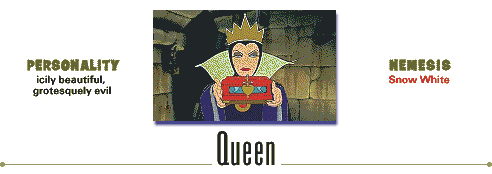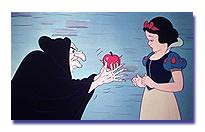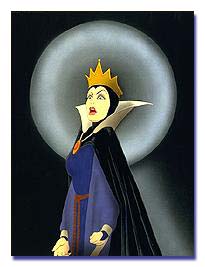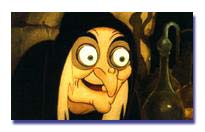 |
 |
 |
 iercely beautiful, the Wicked Queen has
reached an age where her radiance is fading. Insanely jealous of
her lovely young stepdaughter, the Queen forces her to work as a
scullery maid in the hope that drudgery will tarnish the girl's
blossoming beauty. When the Magic Mirror reveals that Snow White
has finally become "more fair than thee," she plots the girl's
death in a rage so twisted that she's eventually willing to
sacrifice her own beauty to destroy Snow White's. She uses
witchcraft to transform herself into a hunchbacked old peddler and
succeeds in persuading the naive girl to accept her poisoned apple.
Unknowingly, however, she's wrought the means of her own demise.
For, though her disguise serves the terrible deed, that same feeble
body will hinder her escape. iercely beautiful, the Wicked Queen has
reached an age where her radiance is fading. Insanely jealous of
her lovely young stepdaughter, the Queen forces her to work as a
scullery maid in the hope that drudgery will tarnish the girl's
blossoming beauty. When the Magic Mirror reveals that Snow White
has finally become "more fair than thee," she plots the girl's
death in a rage so twisted that she's eventually willing to
sacrifice her own beauty to destroy Snow White's. She uses
witchcraft to transform herself into a hunchbacked old peddler and
succeeds in persuading the naive girl to accept her poisoned apple.
Unknowingly, however, she's wrought the means of her own demise.
For, though her disguise serves the terrible deed, that same feeble
body will hinder her escape. |
|
 |
 Actress Lucille LaVerne was chosen to voice both the Wicked Queen
and the hag Witch because of her versatile voice intonations. Yet
when she first started voicing the Witch, the recording session
director commented that her intonations were too polished, too much
like the Queen. After excusing herself for a moment she returned to
perform a gravelly voice that now surpassed the director's
expectations. Curious, he asked what she'd changed. Smiling a
toothless grin, she explained she had just removed her false
teeth.
Actress Lucille LaVerne was chosen to voice both the Wicked Queen
and the hag Witch because of her versatile voice intonations. Yet
when she first started voicing the Witch, the recording session
director commented that her intonations were too polished, too much
like the Queen. After excusing herself for a moment she returned to
perform a gravelly voice that now surpassed the director's
expectations. Curious, he asked what she'd changed. Smiling a
toothless grin, she explained she had just removed her false
teeth. |
|
 |
 The Queen is often referred to as "Queen Grimhilde" in Disney
publications of the 1930s. Her appearance was inspired by the Helen
Gahagan character in the film "She" (1935).
Film: "Snow White and the Seven Dwarfs" (1937)
Voice Artist: Lucille LaVerne
The Queen is often referred to as "Queen Grimhilde" in Disney
publications of the 1930s. Her appearance was inspired by the Helen
Gahagan character in the film "She" (1935).
Film: "Snow White and the Seven Dwarfs" (1937)
Voice Artist: Lucille LaVerne |
|
 |
 |
 |
|
|
 |
 |
 |
|
|
 |
|
 |